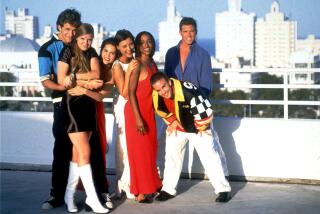Real Life in a Fantasy World
- Share via
In this postmodern pop world, a home is no longer a man’s castle. “Home,” as Elvis Costello once sang, “isn’t where it used to be. Home is anywhere you hang your head.”
And, according to MTV’s “The Real World,” home is also something you audition for, a place filled with cameras and lights, a place you sign up to share for four months with six strangers and a television audience of millions in 60 countries, a place with no doors except on bathrooms (and even those don’t lock). This is home as ant farm.
Now in its eighth season, “The Real World” brings together young men and women, seeking their 15 minutes of fame, who vie for a place on the unscripted, real-life show that chronicles the lives of seven strangers randomly thrown together.
Nearly 25,000 applied for the seven spaces in a luxury home in Honolulu’s Diamond Head district, a wealthy enclave on the Oahu coast --not exactly the kind of place a bunch of 20-somethings would normally choose as a beach pad.
Part of the appeal for the seven, as well as the TV audience (mostly between the ages of 12 and 34), is the fantasy element. In all eight seasons, the “kids,” as producer Matt Kunitz calls them, reside in unlikely luxury. The pay, however, is anything but star level.
“They get paid very small ‘story rights,’ ” explains Kunitz, enough to buy a used car at the end--a really old used car.
Each year, the show has been in a different city. Whether it’s Venice Beach, London or Seattle, “The Real World” staff chooses a city, finds a site and converts it into both home and television production set for months at a time.
Kunitz and crew not only give the house a fashion make-over, they must also put in lighting and other equipment that will allow them to obtain broadcast-quality sound and video virtually anywhere on the site. The Hawaii house, all 3,760 square feet of it, went from “boring,” as Kunitz called it, to “fly,” as the occupants might say, under the direction of production designer Nina Flebbe.
Flebbe transformed the staid, plantation-style residence into a fantasy playhouse, adding a fish pond, bridge and waterfall to the front, a flaming volcano to the swimming pool, and splashing bright colors and Disney-like touches to the interior.
“I used a lot of bright beach colors, water and sunrise colors, with Gauguin’s Polynesian work as a template,” Flebbe explains. Plastic foam topped with faux cement yielded a rock-like look, while hula lamps and dolls contributed to the island feel.
In previous seasons, Ikea provided the furniture. But Flebbe wanted to go Hawaiian to suit the location, so vintage island pieces, many made of local koa wood or bamboo, were borrowed from the Hawaii Antique Center.
Does the house itself affect the residents? Definitely, says Kunitz.
“There was a big difference from Seattle. Right away in Hawaii, two cast members stripped off their clothes and went skinny-dipping.”
Viewers who want to copy the look of MTV’s Hawaii house can take tips, like cutting a surfboard in half to make a bar, or go beyond the usual color palette for interiors.
Even Flebbe, who lives in Seattle, has been inspired by the show. “It’s nice to see how creative you can be with color. I’ve applied that to my house.”
Kunitz too has taken some decorating tips from “The Real World.” He’s been with the show almost since the beginning, and some item or other from each house, from a mural to a wood fish, now has a place in his Brentwood apartment.
“The Real World” is broadcast at 10 p.m. Tuesdays on MTV.
More to Read
The complete guide to home viewing
Get Screen Gab for everything about the TV shows and streaming movies everyone’s talking about.
You may occasionally receive promotional content from the Los Angeles Times.






